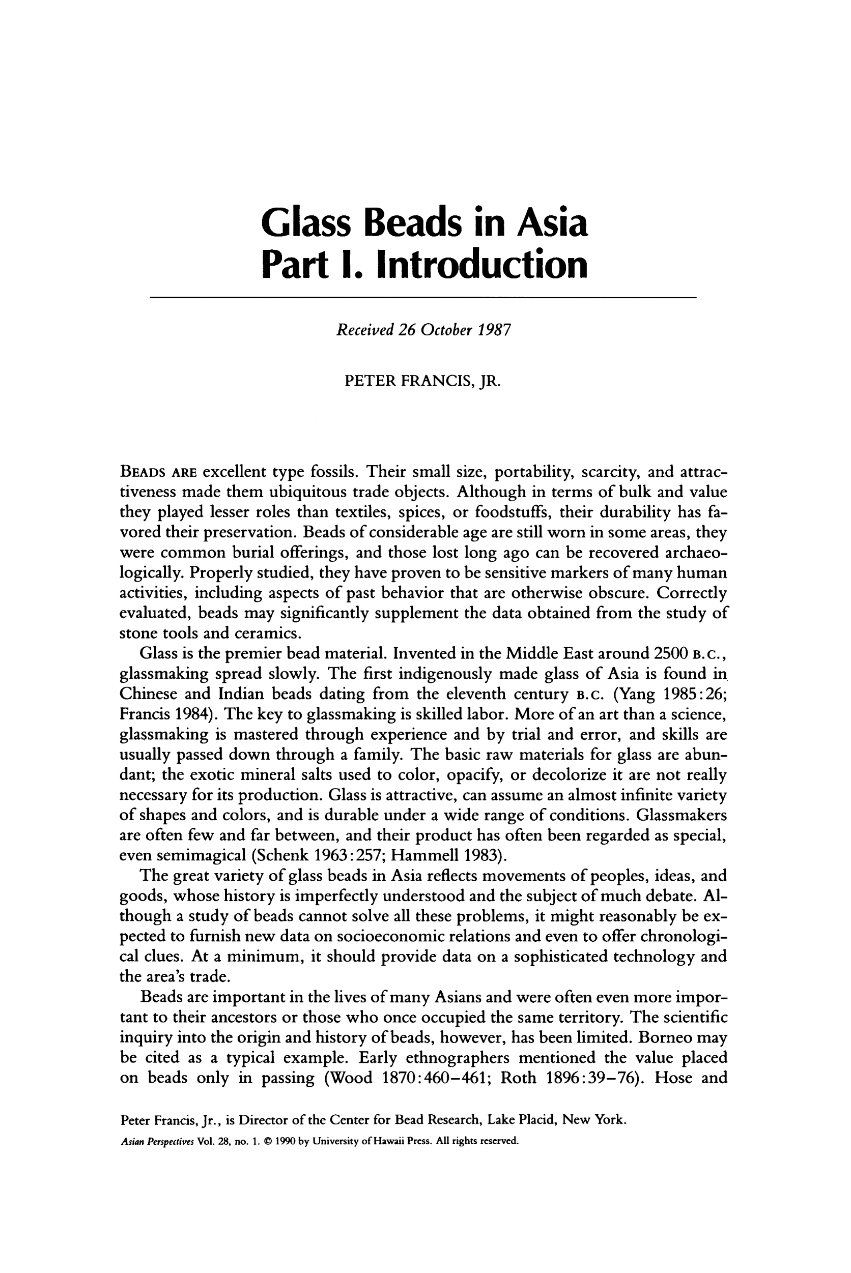|
|
|
|---|

| ชื่อผู้แต่ง | PETER FRANCIS, JR. |
| วารสาร/นิตยสาร | Asian Perspectives, |
| เดือน | ตุลาคม |
| ปี | 1987 |
| ปีที่ | 28 |
| ฉบับที่ | 1 |
| หน้าที่ | 1-21 |
| ภาษา | อังกฤษ |
| หมายเหตุ | <p>แปลจากภาษาอังกฤษ</p> |
บทความเสนอว่าลูกปัดอินโดแปซิฟิกขนาดเล็กน่าจะผลิตในท้องถิ่นในเอเชียแน่นอน โดยวิเคราะห์จากการวิเคราะห์ผลงานจำนวนหนึ่งจากทั้งยุคต้นประวัติศาสตร์และยุคกลางจากสถานที่ต่างๆ แสดงให้เห็นว่าพวกมันทำจากแก้วซึ่งแตกต่างจากแก้วที่ผลิตในภูมิภาคการผลิตแก้วร่วมสมัยของตะวันตก
In this introduction we have principally treated the question of non-Asian influ ences on Asian bead assemblages. Since it is equally dangerous to assume that all beads from a particular site were locally made as it is to assume that they were all imported, sifting the evidence to determine what may be considered local or at least Asian in origin and what may have been imported from outside the area is a neces sary first step in studying Asian glass beads.
The small drawn Indo-Pacific beads definitely appear to be of Asian origin. The analyses of a number of them from both the early historic and medieval periods from a variety of sites show that they are made of a glass that is unlike glass produced in contemporary glassmaking regions of the West.
The often cited evidence for Roman glass beads in Southeast Asia disappears when examined critically. There certainly are Roman beads along the Silk Route in China and in northwestern India. Otherwise, the sites that have yielded Roman beads-such as Mantai, Sri Lanka, Arikamedu, India, Kyonju, Korea, and possibly Oc-eo, Viet Nam-all have only a very few such beads, and usually only single finds. The checquer beads of Sarawak may be medieval European in origin. Ancient European glass beads in Asia west of the Indus or beyond the Silk Route are ex tremely rare.
On the other hand, modern European glass beads of the last few centuries are quite common. They have been found and published from many sites and constitute an important intrusive element. Many of the heirloom beads of Southeast Asia and quite a few archaeologically recovered beads are of this type, usually Venetian, Bohemian/Czech, or possibly Dutch. Both ethnographers and archaeologists must recognize them for what they are in order to make sense out of a given assemblage.
Modern European glass beads aside, most glass beads in South Asia and East Asia appear to have local origins. These will be the subject of the following parts of this series. Part II will discuss the common Indo-Pacific beads, and Part III beads of other types.
ลูกปัดแก้วที่ค้นพบบริเวณเอเชียตะวันออกเฉียงใต้

แปลจากภาษาอังกฤษ
บทความเสนอว่าลูกปัดอินโดแปซิฟิกขนาดเล็กน่าจะผลิตในท้องถิ่นในเอเชียแน่นอน โดยวิเคราะห์จากการวิเคราะห์ผลงานจำนวนหนึ่งจากทั้งยุคต้นประวัติศาสตร์และยุคกลางจากสถานที่ต่างๆ แสดงให้เห็นว่าพวกมันทำจากแก้วซึ่งแตกต่างจากแก้วที่ผลิตในภูมิภาคการผลิตแก้วร่วมสมัยของตะวันตก
In this introduction we have principally treated the question of non-Asian influ ences on Asian bead assemblages. Since it is equally dangerous to assume that all beads from a particular site were locally made as it is to assume that they were all imported, sifting the evidence to determine what may be considered local or at least Asian in origin and what may have been imported from outside the area is a neces sary first step in studying Asian glass beads.
The small drawn Indo-Pacific beads definitely appear to be of Asian origin. The analyses of a number of them from both the early historic and medieval periods from a variety of sites show that they are made of a glass that is unlike glass produced in contemporary glassmaking regions of the West.
The often cited evidence for Roman glass beads in Southeast Asia disappears when examined critically. There certainly are Roman beads along the Silk Route in China and in northwestern India. Otherwise, the sites that have yielded Roman beads-such as Mantai, Sri Lanka, Arikamedu, India, Kyonju, Korea, and possibly Oc-eo, Viet Nam-all have only a very few such beads, and usually only single finds. The checquer beads of Sarawak may be medieval European in origin. Ancient European glass beads in Asia west of the Indus or beyond the Silk Route are ex tremely rare.
On the other hand, modern European glass beads of the last few centuries are quite common. They have been found and published from many sites and constitute an important intrusive element. Many of the heirloom beads of Southeast Asia and quite a few archaeologically recovered beads are of this type, usually Venetian, Bohemian/Czech, or possibly Dutch. Both ethnographers and archaeologists must recognize them for what they are in order to make sense out of a given assemblage.
Modern European glass beads aside, most glass beads in South Asia and East Asia appear to have local origins. These will be the subject of the following parts of this series. Part II will discuss the common Indo-Pacific beads, and Part III beads of other types.
ลูกปัดแก้วที่ค้นพบบริเวณเอเชียตะวันออกเฉียงใต้